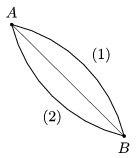 Problem P. 4500. (January 2013)
Problem P. 4500. (January 2013)
P. 4500. A small bead can slide from A to B along the paths shown in the figure. The paths are circular arcs lying in a vertical plane, and they are symmetrical about the straight line through the points A and B. The angle between the straight line and the horizontal is 45o.

a) Along which path will the bead reach point B in a shorter time, and what can we state about the final speed in each case, if there is no friction?
b) What can be stated about the final speeds if friction is not negligible, and the coefficient of friction is the same in both paths?
(4 pont)
Deadline expired on February 11, 2013.
Sorry, the solution is available only in Hungarian. Google translation
Megoldásvázlat. \(\displaystyle a)\) Súrlódásmentes esetben a (2)-es pályán ér le hamarabb, de a végsebesség mindkét pályán ugyanakkora.
\(\displaystyle b)\) Ha mindkét test végig tud csúszni a pályáján, akkor az (1)-es pályán haladó végsebessége lesz nagyobb. (Elképzelhető azonban az is, hogy az (1)-es pályán el sem indul a gyöngy, illetve a (2)-es pályán haladó esetleg útközben megállhat.)
Statistics:
74 students sent a solution. 4 points: Antalicz Balázs, Balogh Menyhért, Emri Tamás, Fekete Panna, Filep Gábor, Juhász Péter, Kaprinai Balázs, Putti Krisztián, Sági Olivér, Soós Tamás Sándor, Tóth Bálint. 3 points: Bősze Zsófia, Fábián Kristóf, Hajós Mátyás, Huszár Emese, Mezősi Máté, Nagy Gergely, Nemes György, Wiandt Péter, Zsiros Ádám. 2 points: 20 students. 1 point: 23 students. 0 point: 11 students.
Problems in Physics of KöMaL, January 2013
